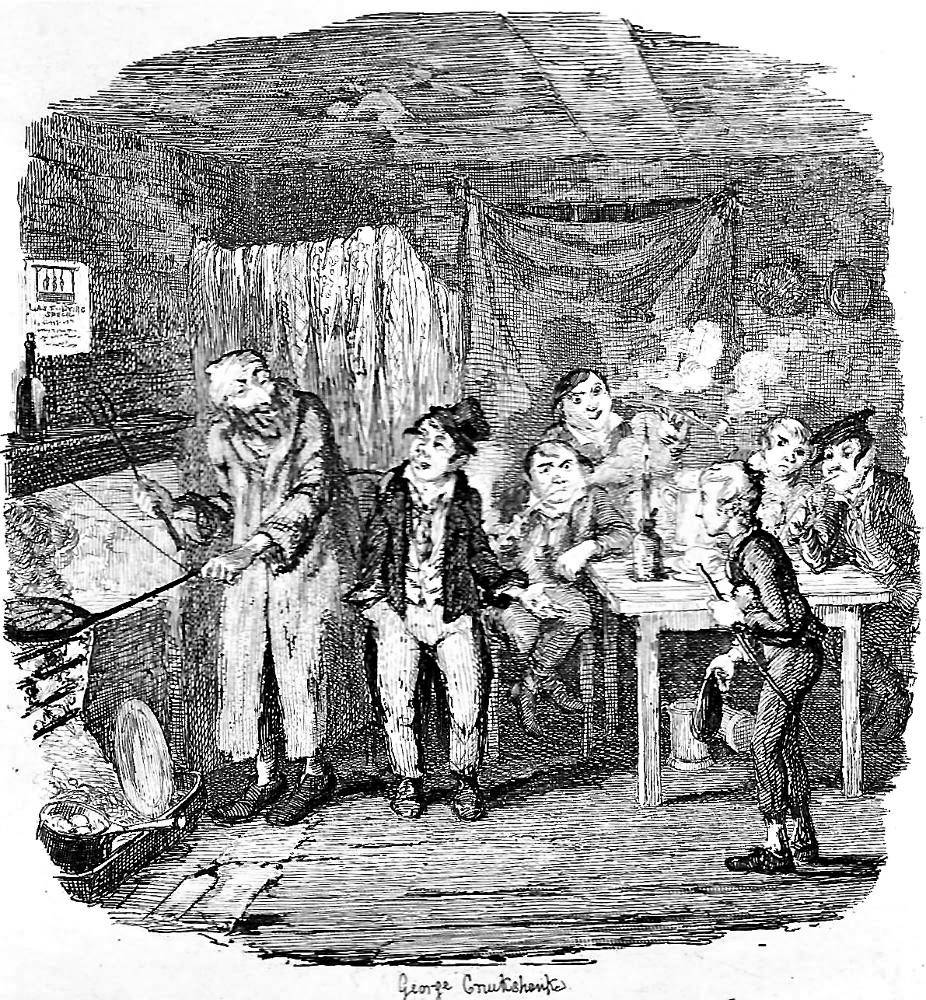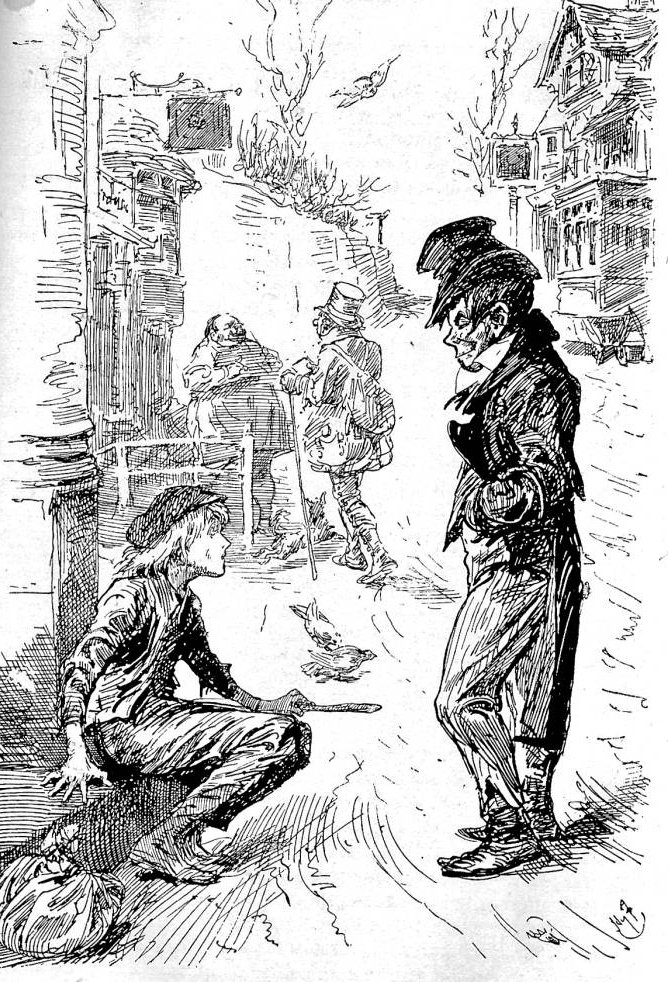"Hullo, my covey! What's the row?"
Frederic W. Pailthorpe
1886
Dickens's Oliver Twist
[Click on image to enlarge it. See below for passage illustrated, commentary and comparisons with other illustrators' work; mouse over the text for links.]
Scanned image and text by Philip V. Allingham.
[You may use these images without prior permission for an scholarly or educational purpose as long as you (1) credit the photographer and (2) link your document to this URL in a web document or cite the Victorian Web in a print one.]
Passage Illustrated
He had been crouching on the step for some time: wondering at the great number of public-houses (every other house in Barnet was a tavern, large or small), gazing listlessly at the coaches as they passed through, and thinking how strange it seemed that they could do, with ease, in a few hours, what it had taken him a whole week of courage and determination beyond his years to accomplish: when he was roused by observing that a boy, who had passed him carelessly some minutes before, had returned, and was now surveying him most earnestly from the opposite side of the way. He took little heed of this at first; but the boy remained in the same attitude of close observation so long, that Oliver raised his head, and returned his steady look. Upon this, the boy crossed over; and, walking close up to Oliver, said,
"Hullo, my covey! What's the row?"
The boy who addressed this inquiry to the young wayfarer, was about his own age: but one of the queerest looking boys that Oliver had ever seen. He was a snub-nosed, flat-browed, common-faced boy enough; and as dirty a juvenile as one would wish to see; but he had about him all the airs and manners of a man. He was short of his age: with rather bowlegs, and little, sharp, ugly eyes. His hat was stuck on the top of his head so lightly, that it threatened to fall off every moment — and would have done so, very often, if the wearer had not had a knack of every now and then giving his head a sudden twitch, which brought it back to its old place again. He wore a man's coat, which reached nearly to his heels. He had turned the cuffs back, half-way up his arm, to get his hands out of the sleeves: apparently with the ultimate view of thrusting them into the pockets of his corduroy trousers; for there he kept them. He was, altogether, as roystering and swaggering a young gentleman as ever stood four feet six, or something less, in his bluchers.
"Hullo, my covey! What's the row?" said this strange young gentleman to Oliver.
"I am very hungry and tired," replied Oliver: the tears standing in his eyes as he spoke. "I have walked a long way. I have been walking these seven days."
"Walking for sivin days!" said the young gentleman. "Oh, I see. Beak's order, eh? But," he added, noticing Oliver's look of surprise, "I suppose you don't know what a beak is, my flash com-pan-i-on?" [Chapter VIII, "Oliver walks to London. He encounters on the road a strange sort of young gentleman," p. 40 in the 1846 edition]
Commentary: Oliver meets the inimitable Artful Dodger
After a week on the road, Oliver enters the town of Barnet on the fringes of what is now Greater London. In fact, today the Borough of Barnet is the metropolitan region's second-largest, but in the period in which Dickens has set the story, it was still just a small market-town north of central London, in the county of Hertfordshire. Footsore, lonesome, and hungry, Oliver watches as the shops open their shutters as the sun comes up. From his vantage point on a door-step he watches the town come to life, and is surprised by the large number of public houses on the high street. And there appears before Oliver one of the novel's most distinctive characters, The Artful Dodger, a skilled pickpocket. Even though the Dodger is still an adolescent, the street-smart thief wears cast-off adult clothing somewhat too big for him, as the Pailthorpe illustration suggests. The Artful (properly, Jack Dawkins) affects the self-confident manner of an adult. Here, Pailthorpe is still complementing scenes which Cruikshank composed. However, in this instance Pailthorpe does have a model: the sixth illustration in the 1871 Household Edition. Fagin's chief pickpocket does not appear in Cruikshank's sequence of illustrations for the early monthly instalments in Bentley's Miscellany. Rather, in the third (April 1837) instalment Cruikshank shows Dawkins among the other waifs in the underworld scene in Fagin's hideout, Oliver introduced to the respectable Old Gentleman.
Pailthorpe has suggested that the meeting occurs before the baker's, upon whose steps the waif from the north (Peterborough, perhaps) has ensconced himself, has opened its shutters. Oliver seems stunned as the much older boy in patched adult clothing, including a slightly battered top-hat, accosts him. Although the text describes in vivid detail the town's commercial centre coming to life, Pailthorpe places no one else in the frame, having plausibly identified the nature of the shop in front of which he introduces Oliver to Jack Dawkins.
Illustrations from Various Editions (1837, 1867, 1871, and 1910)



Left: Sol Eytinge, Junior's The Artful Dodger and Charley Bates. Centre: George Cruikshank's original version of Oliver introduced to the respectable Old Gentleman. Right: Harry Furniss's Charles Dickens Library Edition illustration (1910) Oliver falls in with the Artful Dodger . [Click on images to enlarge them.]

Above: James Mahoney's sixth Household Edition illustration, set at Barnet: "Hullo, my covey! What's the row?" (1871).
Related Material
- Oliver Twist Illustrated, 1837-1910
- Oliver Twist as a Triple-Decker
- Oliver untainted by evil
- Like Martin Chuzzlewit, it agitates for social reform
Bibliography
Bentley, Nicolas, Michael Slater, and Nina Burgis. The Dickens Index. New York and Oxford: Oxford U. P., 1990.
Cohen, Jane Rabb. "George Cruikshank." Charles Dickens and His Original Illustrators. Columbus: Ohio State U. P., 1980. Pp. 15-38.
Darley, Felix Octavius Carr. Character Sketches from Dickens. Philadelphia: Porter and Coates, 1888.
Davis, Paul. Charles Dickens A to Z: The Essential Reference to His Life and Work. New York: Facts On File, 1998.
Dickens, Charles. The Adventures of Oliver Twist. Illustrated by George Cruikshank. London: Bradbury and Evans, 1838; Chapman and Hall, 1846.
_______. The Letters of Charles Dickens. Ed. Graham Storey, Kathleen Tillotson, and Angus Eassone. The Pilgrim Edition. Oxford: Clarendon, 1965. Vol. 1 (1820-1839).
_______. Oliver Twist. Works of Charles Dickens. Household Edition. 55 vols. Illustrated by F. O. C. Darley and John Gilbert. New York: Sheldon and Co., 1865.
_______. Oliver Twist. Works of Charles Dickens. Diamond Edition. 14 vols. Illustrated by Sol Eytinge, Jr. Boston: Ticknor and Fields, 1867. Vol. XI.
_______. The Adventures of Oliver Twist. Works of Charles Dickens. Household Edition. 22 vols. Illustrated by James Mahoney. London: Chapman and Hall, 1871. Vol. I.
_______. Oliver Twist. Works of Charles Dickens. Charles Dickens Library Edition. 18 vols. Illustrated by Harry Furniss. London: Educational Book Company, 1910. Vol. III.
_______. Oliver Twist. Works of Charles Dickens. The Waverley Edition of the Works of Charles Dickens. Illustrated by Charles Pears. London: Waverley, 1912.
_______. Oliver Twist. Works of Charles Dickens. The Waverley Edition of the Works of Charles Dickens. Illustrated by Charles Pears. London: Waverley, 1912.
Grego, Joseph (intro). Cruikshank's Water Colours. [27 Oliver Twist illustrations, including the wrapper and the 13-vignette title-page produced for F. W. Cosens; 20 plates for William Harrison Ainsworth's The Miser's Daughter: A Tale of the Year 1774; 20 plates plus the proofcover the work for W. H. Maxwell's History of the Irish Rebellion in 1798 and Emmetts Insurrection in 1803]. London: A & C Black, 1903. OT = pp. 1-106]. Book in the Rare Book Collection of the University of Toronto.
Pailthorpe, Frederic W. (Illustrator). Charles Dickens's Oliver Twist. London: Robson & Kerslake, 1886. Set No. 118 (coloured) of 200 sets of proof impressions.
Victorian
Web
Visual
Arts
Illustra-
tion
F. W.
Pailthorpe
Next
Created 11 February 2015 Updated 24 November 2021
